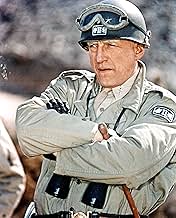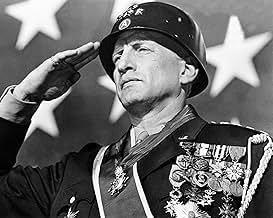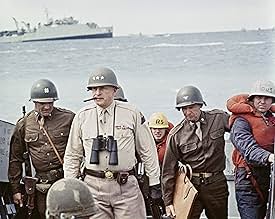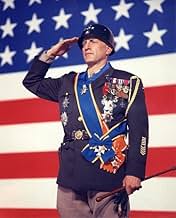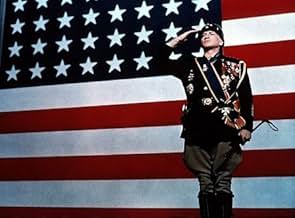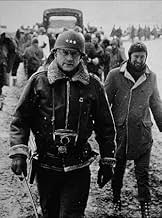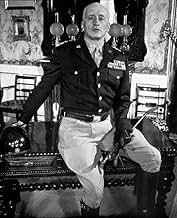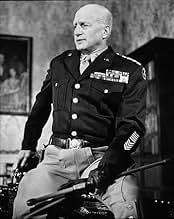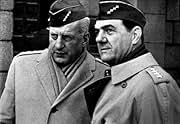Violento, vanitoso e fanatico fino a sfiorare il ridicolo, Patton è un uomo senza macchia e senza paura, una figura indimenticabile che mise a soqquadro l'esercito e che con la sua ossession... Leggi tuttoViolento, vanitoso e fanatico fino a sfiorare il ridicolo, Patton è un uomo senza macchia e senza paura, una figura indimenticabile che mise a soqquadro l'esercito e che con la sua ossessione per la disciplina creò uno degli incidenti più discussi della 2° guerra mondiale.Violento, vanitoso e fanatico fino a sfiorare il ridicolo, Patton è un uomo senza macchia e senza paura, una figura indimenticabile che mise a soqquadro l'esercito e che con la sua ossessione per la disciplina creò uno degli incidenti più discussi della 2° guerra mondiale.
- Regia
- Sceneggiatura
- Star
- Vincitore di 7 Oscar
- 25 vittorie e 8 candidature totali
- General Bradley's Driver
- (as Cary Loftin)
- First Lieutenant Alexander Stiller
- (as Patrick J. Zurica)
- Colonel General Alfred Jodl
- (as Richard Muench)
Riepilogo
Recensioni in evidenza
And that is why Patton works - you have an unambiguous war against and unambiguous evil - Nazi Germany. Whereas Vietnam might have been a tough conflict for even its supporters to explain, World War Two was quite simple - we were the good guys, and they WERE the bad guys. And so you COULD root for the US Army and Patton without feeling a tinge of guilt.
Also superb in the film is everyman Karl Malden as General Omar Bradley, providing the stable and workmanlike leader (and one who rises quicker in the ranks due to it) to Patton's egomaniac.
And Yes, George C. Scott delivers a career-defining performance that is one for the books. Could Brando or Telly Savalas have pulled off the role as well? I don't think so - it was just tailor made for Scott.
Meanwhile, Patton was assigned to London as a decoy to deceive the Germans in a sham operation called Fortitude. The ruse was successful because the German High Command respected Patton more than any other Allied commander and deemed him crucial to any plan to invade mainland Europe. Immediately following the successful invasion, he was put in command of the Third Army in the final Allied thrust against Germany where the headstrong general, once again, proved his mettle as his forces favored speed and aggressive offensive action.
Patton was an interesting character who maintained a flashy larger-than-life image in order to encourage his troops; and he didn't hesitate to get his hands dirty with them. While other officers tried to blend-in with the troops on the battlefield, Patton brazenly displayed his rank insignia. He was a romantic who valued bravery and tenacity above all. All this is effectively conveyed in this ambitious war flick. It's interesting to observe the North African and European theaters of the war from the standpoint of the Allied generals, mostly Patton and Bradley, rather than the typical perspective of the infantry.
THE FILM WAS WRITTEN by Francis Ford Coppola with additional material from Edmund H. North (based on the factual accounts of Ladislas Farago & Omar N. Bradley). It runs 172 minutes and was shot in Spain, Algeria, Morocco, Crete and England, with the opening speech filmed at Bob Hope Patriotic Hall in Los Angeles.
GRADE: A-
Oscars Best Picture Winners, Ranked
Oscars Best Picture Winners, Ranked
Lo sapevi?
- QuizThe movie begins without showing the 20th Century-Fox logo, or any other indication that the film is starting. At military bases across the US theater owners reported that soldiers in the audience would often stand up and snap to attention when they heard the movie's opening line ("Ten-hut!"), assuming it to be a real call to attention.
- BlooperContrary to the way it's portrayed in the film, the controversy over George S. Patton's Knutsford speech was not over his having insulted the Russians (in fact, the Army quickly revised the initial transcript of his remarks to reflect that he had mentioned them). It had to do with his talk of "ruling the world" after the war - members of Congress said he had no business as a general commenting on post-war political affairs, while others objected to the notion of the US, Britain or anyone else "ruling the world."
- Curiosità sui creditiOne of the very, very few Twentieth Century-Fox films in which that company's logo is not shown at all, beginning or end. The film simply begins with the opening speech, and the opening Fox logo is replaced with an in-credit text-only notice after the speech. However, recent television showings have added the logo (not on DVD prints), and the addition is obviously spliced in from another piece of film.
- Versioni alternativeThe Italian version is approximately 20 minutes shorter and removes all scenes set in the German Military HQ and/or showing German officers: although the credits still include the names of German performers, like Karl Michael Vogler as Marshall Rommel, their characters never appear onscreen in the Italian release.
- ConnessioniEdited into Un uomo d'azione (1972)
- Colonne sonoreTo the Colors
(uncredited)
Traditional bugle call used in lieu of the National Anthem. Played at the opening scene.
I più visti
Dettagli
- Data di uscita
- Paese di origine
- Sito ufficiale
- Lingue
- Celebre anche come
- Patton
- Luoghi delle riprese
- Cabo de Gata, Almería, Andalucía, Spagna(desert scenes)
- Azienda produttrice
- Vedi altri crediti dell’azienda su IMDbPro
Botteghino
- Budget
- 12.000.000 USD (previsto)
- Lordo Stati Uniti e Canada
- 61.749.765 USD
- Lordo in tutto il mondo
- 61.749.765 USD
- Tempo di esecuzione
- 2h 52min(172 min)
- Colore
- Proporzioni
- 2.20 : 1



